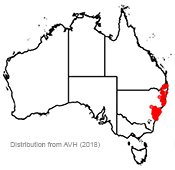Epacris longiflora
 |
 |
Fuchsia Heath
Epacris longiflora, commonly known as Fuchsia Heath, Native Fuchsia, Scarlet Epacris or Cigarette Flower, is a member of the heath family Ericaceae in the subfamily Epacridoideae. Epacris longiflora grows in wet coastal heath to the fringes of eucalypt forests and woodlands. It favours a well-drained but moist sandy soil and is particularly common along seepage lines on sandstone, such as in the Sydney Sandstone Basin. The native range extends from coastal New South Wales north of Berry to southern Queensland. It was exported to Europe as a popular ornamental plant in the early 19th century and elsewhere since.
Epacris longiflora is a medium-sized spreading shrub with long arching stems and an attractive display of pendulous flowers. Leaves are small and ovate with an acuminate tip and arranged in a whorled pattern. Flowers are displayed year-round but peak around summer and autumn. As the name suggests flowers are quite long for a heath, between 17mm to 40mm, with a tubular corolla which is red at the base to white near the end of the lobes although a variety with entirely white corolla does occur. Flowers form an attractive display with up to 100 per stem.
Epacris longiflora is mainly cultivated through cuttings. Removing the leaves from the lower two-thirds of a 30–60 cm long cutting but leaving the nodes intact can increase the propagation success. Other procedures such as "wounding" the bark by stripping back a small amount or the use of root growth hormone have also shown some success. Epacris longiflora can also be propagated from seed however the collection of Epacris seed can be difficult. The plant has very fine root hairs and does not respond well to disturbance or movement.
Epacris longiflora does best in well-draining sandy soils, planted in partial shade protected from frost or the full sun. Mulch around the base will help retain soil moisture which is important as Epacris longiflora won't tolerate drying out. Epacris longiflora forms impressive displays when planted in mass or can make an attractive container plant. The natural habit is quite straggly and spreading, however the plant does respond well to pruning producing a tidier more erect shrub. Weeding around the base of the plant can protect it from high humidity and excess moisture which can lead to plant death.
There are currently no major threats to Epacris longiflora except the previously mentioned weeds, habitat loss or fire. Epacris longiflora regenerates from soil-stored seed bank in the event of fire so frequent burning could kill natural populations.
Edward Calaby, Volunteer Botanical Training Program Participant 2018
Name meaning: Epacris longifloraEpacris - from the Greek epi- meaning "upon" and akris meaning "hilltop" longiflora - from Latin longus meaning "long" or "extended" and flos/florus meaning "flower" |
References:
Australian Native Plant Society (Australia) (2009). The Australian Heath Family – Propagation. Available at http://anpsa.org.au/epacris2.html [Accessed February 2018].
Australian Native Plant Society (Australia) (2017). Epacris longiflora. Available at http://anpsa.org.au/e-lon.html [Accessed February 2018].
Benson, D. and McDougall, L. (1995). Ecology of Sydney plant species Part 3: Dicotyledon families Cabombaceae to Eupomatiaceae. Cunninghamia 4(2): 217–431.
Maiden J.H. (1895-98). The flowering plants and ferns of New South Wales, with especial reference to their economic value. Sydney: Govt. Printer.
Powell, J.M. (1992) Epacris longiflora Cav. PlantNET (The NSW Plant Information Network System). Royal Botanic Gardens and Domain Trust, Sydney. Available at http://plantnet.rbgsyd.nsw.gov.au [Accessed February 2018]
Ross, L. (2015). Fuchsia heath (Epacris longiflora), Garden Clinic. Available at https://www.gardenclinic.com.au/how-to-grow-article/fuschia-heath-epacris-longiflora?pid=44204 [Accessed February 2018].
Walters, B. (2009). Australian Heaths, Australian Native Plants Society (Australia). Available at http://www.anpsa.org.au/APOL2009/apr09-2.html [Accessed February 2018].
![An Australian Government Initiative [logo]](/images/austgovt_brown_90px.gif)


